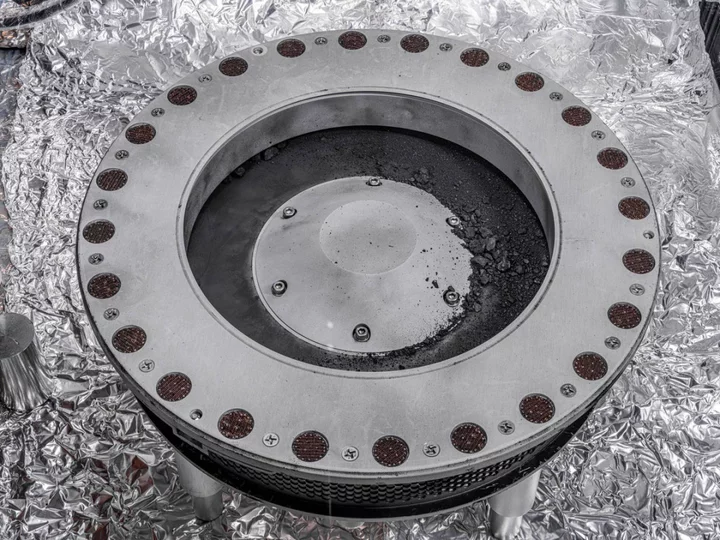
Scientists reveal plan to use lasers to build roads on the moon
We could shoot lasers at the lunar soil to help us live on the Moon, scientists have proposed. By melting the lunar soil into a more solid, layered substance, we might be able to build paved roads and landing pads on the Moon’s surface, a new study suggests. Many space agencies including Nasa have plans to establish semi-permanent bases on the Moon, which would both allow us to better study it but also serve as a stop off on the way to Mars and elsewhere in the solar system. The Moon’s surface is a tough place t land and live, however. The dust of the soil tends to get kicked up by landers – and the low gravity means that it floats around after it is disturbed, potentially finding its way into equipment. As such, future Moon colonies may require robust roads and landing pads to allow for us to travel both to and around the Moon. But it is unlikely we would be able to transport materials to build them, given the cost of doing so, leading scientists to look at what is available there already. In the new study, scientists examined whether lunar soil could be turned into something more substantial by using lasers. And they had some success, finding that lunar dust can be melted down into a solid substance. They used a variety of different sized and types of lasers to see what they would produce. The best used a 45 millimetre diameter laser beam to make hollow triangular shapes that were about 250 millimetres in size. Those pieces could be locked together to create solid surfaces that could be placed across the Moon’s surface, they suggest, and then used as roads and landing pads. On the Moon, the same approach would require a lens of around 2.37 metres squared, which would have to be transported from Earth. That could then be used to concentrate sunlight, rather than using a laser, and so allow the material to be created with relatively small equipment. The plan is reported in a new journal article, ‘Laser melting manufacturing of large elements of lunar regolith simulant for paving on the Moon’, published in Scientific Reports. Read More Nasa opens up pieces of a distant asteroid transported back to Earth Earth hit by a huge solar storm that would devastate civilisation, trees show Incels using TikTok to spread ‘hateful beliefs’, research suggests
2023-10-12 23:06

Banks in EU Get World’s First ESG Add-On to Capital Rules
In a global first, Europe’s main bank regulator is revising the framework that sets capital requirements so that
2023-10-12 22:33

EU to Push ‘Made in Europe’ Tag in Green Industry, Sefcovic Says
The European Union will be much more “assertive” in touting a “made in Europe” approach to ensure that
2023-10-12 22:08

Why Exxon’s One-Time Adversary Unanimously Backed Mega Deal
When a then little-known fund defeated Exxon Mobil Corp. in a climate-charged activist battle in 2021, snagging three
2023-10-12 22:01

Scientists unearth a secret hidden within the Mona Lisa
The Mona Lisa has been the subject of awe and fascination for centuries, with experts from around the world desperate to solve the mystery behind her iconic, enigmatic smile. Now, thanks to X-ray technology, scientists have begun to uncover the secrets of Leonardo da Vinci’s legendary portrait, and explain how he was able to create something so mind-bending with just a few strokes of a brush. The research, published in the Journal of the American Chemical Society on Wednesday, suggests that the Italian Renaissance master may have been in a particularly inventive mood when set about crafting the piece in the early 16th century. "He was someone who loved to experiment, and each of his paintings is completely different technically," Victor Gonzalez, the study's lead author, told the Associated Press.. Gonzalez, who has studied the chemical compositions of dozens of works by Leonardo and other artists, discovered that there was something special about the paint used for the Mona Lisa. Specifically, the researchers found a rare compound, called plumbonacrite, in Leonardo's first layer of paint. The discovery confirmed that Leonardo most likely used lead oxide powder to thicken and help dry his paint as he began working on the portrait. He is thought to have dried the powder, which has an orange colour, in linseed or walnut oil by heating the mixture to make a thicker, faster-drying paste. "What you will obtain is an oil that has a very nice golden colour," Gonzalez said. "It flows more like honey." Carmen Bambach, a specialist in Italian art and curator at New York's Metropolitan Museum of Art, who was not involved in the study, called the research "very exciting". She emphasised that any scientifically proven new insights into Leonardo's painting techniques are "extremely important news for the art world and our larger global society." Finding plumbonacrite in the Mona Lisa attests "to Leonardo's spirit of passionate and constant experimentation as a painter—it is what renders him timeless and modern," Bambach said. The paint fragment Gonzalez and his team analysed for their study was taken from the base layer of the painting and was barely visible to the naked eye. It was no larger than the diameter of a human hair, and came from the top right-hand edge of the picture that now takes pride of place in Paris’s Louvre Museum. The scientists peered into the sample’s atomic structure using X-rays in a synchrotron – a large machine that accelerates particles to almost the speed of light. This allowed them to unravel the speck's chemical makeup and detect the plumbonacrite. The compound is a byproduct of lead oxide, allowing the researchers to say with more certainty that Leonardo likely used the powder in his paint recipe. "Plumbonacrite is really a fingerprint of his recipe," Gonzalez said. "It's the first time we can actually chemically confirm it." After Leonardo, Dutch master Rembrandt may have used a similar recipe when he was painting in the 17th century; Gonzalez and other researchers have previously found plumbonacrite in his work, too. "It tells us also that those recipes were passed on for centuries," Gonzalez said. "It was a very good recipe." Still, the ‘Mona Lisa’—said by the Louvre to be a portrait of Lisa Gherardini, the wife of a Florentine silk merchant—and other works by Leonardo still have other secrets to tell. "There are plenty, plenty more things to discover, for sure,” Gonzalez said. “We are barely scratching the surface.” Sign up for our free Indy100 weekly newsletter Have your say in our news democracy. Click the upvote icon at the top of the page to help raise this article through the indy100 rankings.
2023-10-12 21:53

Female frogs fake their own deaths to avoid sex with overzealous males
Some female frogs will go to the extent of faking their own deaths to avoid sex with their male counterparts, a new study has revealed. Researchers in Berlin and Finland focused on the European common frog for their investigation owing to the often alarming nature of the species' mating process. The short breeding season means that several males often cling to a single female – in a pile-on that can cause the female to drown. (So, pretty understandable that they might want to avoid this.) For the research published in the Royal Society Open Science, European common frogs were collected and divided into tanks where there were two females and one male in each. Before this research, it was thought that the females couldn't defend themselves against the aggressive amorous act. However, a number of the wily participants displayed the three avoidance behaviours. A rotation technique to escape mating was a popular option – carried out by 83 per cent of the females. While nearly half of them (48 per cent) mimicked how male frogs sound to trick them into letting them go. In 33 per cent of the females, the researchers recorded a stiffening of arms and legs for two minutes, in a convincing bid to play dead. Out of the females who got mounted by a lustful male, almost half were able to escape thanks to at least one of these avoidance behaviours. “The smaller females also showed the full repertoire of behaviours more often than the larger females," the researchers noted, and younger females were more likely to pretend they were dead. However, question marks remain on whether the frogs fake their death as a conscious choice or whether it is a stress response or even a means to test the male’s strength and endurance. “I think even if we call this species a common frog and think we know it well, there are still aspects we don’t know and perhaps haven’t thought about," Dittrich explained to The Guardian. Sign up to our free Indy100 weekly newsletter Have your say in our news democracy. Click the upvote icon at the top of the page to help raise this article through the indy100 rankings.
2023-10-12 21:12

‘Ring of Fire’ Eclipse This Weekend Will Send US Solar Power Plunging
US grid operators are set to face their largest controlled experiment for dealing with big swings in renewable
2023-10-12 21:00

How China Left the World Far Behind in the Battery Race
This is one of the stories in Akshat Rathi’s new book Climate Capitalism, which is out today. Akshat
2023-10-12 20:00

China's Xi spurs efforts in core technologies -state media
BEIJING China's President Xi Jinping has called for speeding up efforts to make breakthroughs in core technologies, state
2023-10-12 19:57

Nasa opens up pieces of a distant asteroid transported back to Earth
Nasa has revealed chunks of a distant asteroid that were transported back down to Earth. The dark, dusty sample comes from a 4.5-billion-year-old asteroid, and might include the “building blocks of life”, the space agency said. Already, the material from the asteroid Bennu has been found to include high-carbon content and water, the space agency said. But it will be distributed around the world with a view to finding out everything from the history of our solar system to how life came about. Scientists and space agency leaders showed photos and video of the asteroid material - returned to Earth last month - at a live streamed event at the Johnson Space Centre in Houston, Texas. The display came after a capsule containing an estimated 250g of rocks and dust collected from asteroid Bennu, touched down in the Utah desert near Salt Lake City on September 24. Nasa has said it was “the biggest, carbon-rich asteroid sample ever delivered to Earth”, and its contents have now been hailed as “scientific treasure”. Nasa administrator Bill Nelson said the sample will “help scientists investigate the origins of life on our own planet for generations to come”. He added: “Almost everything we do at Nasa seeks to answer questions about who we are and where we come from. “Nasa missions like Osiris-Rex will improve our understanding of asteroids that could threaten Earth while giving us a glimpse into what lies beyond. “The sample has made it back to Earth, but there is still so much science to come - science like we’ve never seen before.” Almost 60 million miles away, asteroid Bennu is a 4.5-billion-year-old remnant of our early solar system and scientists believe it can help shed light on how planets formed and evolved. The spacecraft launched on September 8 2016 and arrived at Bennu in December 2018. It dropped the samples off sealed in a capsule last month. “Already this is scientific treasure,” said the mission’s lead scientist, Professor Dante Lauretta, of the University of Arizona on Wednesday. In a statement, he added: “As we peer into the ancient secrets preserved within the dust and rocks of asteroid Bennu, we are unlocking a time capsule that offers us profound insights into the origins of our solar system. “The bounty of carbon-rich material and the abundant presence of water-bearing clay minerals are just the tip of the cosmic iceberg. “These discoveries, made possible through years of dedicated collaboration and cutting-edge science, propel us on a journey to understand not only our celestial neighbourhood but also the potential for life’s beginnings. “With each revelation from Bennu, we draw closer to unravelling the mysteries of our cosmic heritage.” Nasa‘s mission goal was to collect was 60 grams of asteroid sample. But when the canister lid was opened, Nasa said scientists discovered “bonus material” covering the outside of the collector head, canister lid, and base. There was so much extra material it slowed down the process of collecting and containing the primary sample, Nasa said. Scientists are not sure exactly how much of Bennu they brought back because the main sample chamber has not yet been opened. Mr Lauretta said: “It’s been going slow and meticulous, but the science is already starting.” He said there is “a whole treasure chest of extraterrestrial material” still to be examined. During Wednesday’s press conference, Osiris-Rex sample analyst Daniel Glavin added: “This stuff is an astrobiologist’s dream, I just can’t wait to get at it. “We’re going to learn so much about the origin of the solar system, the evolution and potentially how even life started here on Earth.” Additional reporting by agencies Read More ‘Ring of fire’ solar eclipse this month will be last until 2046 Prada to design Nasa’s next-gen space suits for Artemis astronauts 1.2 mile-high ‘dust devil’ spotted on Mars by Nasa’s Perseverance rover Rover captures one-mile-high whirlwind on Mars Earth hit by a huge solar storm that would devastate civilisation, trees show Scientists see afterglow from huge planets crashing into each other for first time
2023-10-12 19:57

X removes hundreds of Hamas-affiliated accounts since attack, CEO says
The X social media platform has removed hundreds of Hamas-affiliated accounts and taken action to remove or label
2023-10-12 19:27

India arrests Chinese smartphone executive in fraud probe
An executive at Vivo, one of China's top smartphone makers, has been arrested in India in connection with a money laundering probe, raising fears of a renewed crackdown on Chinese businesses in the country.
2023-10-12 19:02
You Might Like...

Westinghouse and Bechtel Solidify Project Team for AP1000® Nuclear Power Program in Poland

Meta scrambles to fix Instagram algorithm connecting ‘vast paedophile network’

Korea’s Internet Leader to Unfurl Entry in ChatGPT-Style AI Race

Bill Gates says AI risks are real but nothing we can't handle

EU Aims to Boost Its Wind Industry to Counter China’s Clean Tech Ambitions

‘Billions’ of Intel computers potentially affect by huge security vulnerability

Sydney Blanketed in Toxic Smoke for Days Following Planned Burns

Sierra Space Appoints Industry Veteran Jen Splaingard to Lead Transformative Engineering and Test Organization
